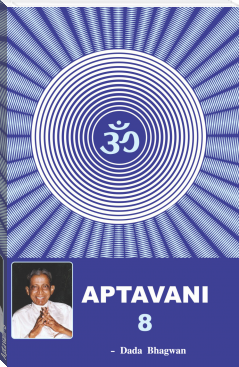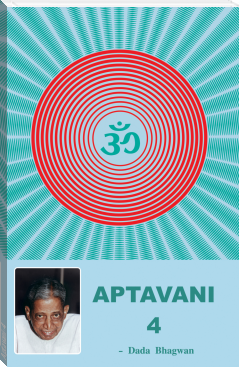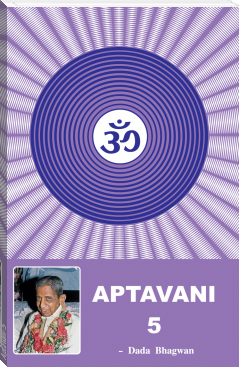Aptavani-8 by Dada Bhagwan (affordable ebook reader .txt) 📖

- Author: Dada Bhagwan
Book online «Aptavani-8 by Dada Bhagwan (affordable ebook reader .txt) 📖». Author Dada Bhagwan
‘The Parmatma (the Absolute Soul) is complete, and I am a part of Him.’ – To dispel this misconception, the Gnani gives precise elucidation, saying that there are infinite numbers of souls, and they are all independent. That which has form, can be broken into pieces, but can you make pieces out of something that has no form? When it becomes a piece, how can you make it whole again? Can you make pieces out of the Lord?
The sun cannot become a ray, and a ray can never become the sun. An eternal element is always indivisible. By however much the layers of ignorance are shed, that much light of Knowledge will be exposed. When the coverings of all the regions (pradesho) of the Atma (Self) are uncovered, the full effulgence of the Absolute Soul (Parmatma) will illuminate the entire universe.
Part Two
Who Am I ? How To Know This?
Atma-Parmatma, Brahma-Parabrahma, Jiva-Shiva, Ishwar-Parmeshwar, are all words that describe the phases of the Atma. When the phase changes, the state that is felt also changes; however, the original element remains the same. Because of change in the circumstance, one is a husband at home, a boss in the shop and a lawyer in court. But he remains the same everywhere.
What is the difference between the living being (jiva; embodied self) and the Self (Shiva)? You yourself are Shiva, but because of illusion (bhranti), you believe that you are just a living being; mortal (jiva). Once the illusion of separation breaks, the separation of jiva (self) and Shiva (Self) is broken, theliving being andthe Self (jiva-Shiva) become one.
As long as the living being (jiva; self) believes that the state of the worldly life (sansar) is really its own, it undergoes the cycles of birth and death. When living and dying ends, it is then the immortal Self (Shivatma).
The living being (jiva) has karma, and the Atma is without karma. But the Atma in them both is the same. The living being (self) is the doer- sufferer (karta-bhokta); whereas the Atma is the non-doer (akarta) – non-sufferer (abhokta)! As long as you believe: ‘You are God, and I am your devotee’, the difference will exist. When you have the awareness: ‘I am myself the Absolute Soul ( Parmatma)’, you will no longer have that separation and you will have become free from all passions of attachment and abhorrence (vitarag). Free from fear (nirbhaya)! And Greatly Liberated (Mahamukta)!
God(Ishwar) and Absolute God (Parmeshwar) – Ishwar is the one with attachment-abhorrence (raag-dwesh), he has the ego of doership and it is he who becomes entranced (murchhit) with temporary things; whereas the Parmeshwar is devoid of attachment ( vitarag); a non-doer, that only worships its own eternal state. Nevertheless the state of Ishwar is a sacred state (vibhuti-swaroop). The end of adverse internal meditation that hurts oneself (artadhyan), and adverse internal meditation that hurts oneself and others ( raudradhyan), is the first link to the state of detachment from attachment and abhorrence (vitaragata).
There is nothing wrong in saying, “I am Chandubhai”, but it should not be so in your belief.
The identification of the milestones on the way to attaining the state of the Absolute Soul (Parmatma), gives the traveler a complete security (reassurance) about the path.
As long as there is the desire for worldly pleasures and the propensity of the tendencies (vruttis) is to wander around in search of worldly pleasures, it is considered an outwardly-soul (bahirmukhi-atma) or ignorant soul (mudhatma). In the ignorant state, the embodied self (jivatma) only has the awareness of its existence (astitva). It believes that all of the attachments of the non-Self body complex ( pudgal) are its own, which is the first sign. The second sign is where, from the state of ignorance, one comes into the state of the inner awakened Soul (antaratma dasha), when all the tendencies that were roaming around outwardly, turn inward towards one’s home (the Self). When the Gnani Purush, through an instrumental intent (nimit bhaav), gives the ignorant soul (mudhatma) the conviction that the attachments of the non-Self body complex (pudgal) are not Your, and that You are the Absolute Soul (Parmatma), then for the first time, the conviction of the state ‘I am’, becomes one with the Absolute Soul (Parmatma). Now, not only is there awareness of existence (astitva), but one also has awareness of the elemental nature (vastutva) that is, ‘Who am I?’ This inner awakened Soul (antaratma)state means the “interim government” is established.
The interim government (antaratma) has two jobs. During worldly interaction (vyavahar), using applied awareness (upayog), one settles matters with equanimity, and during one’s free time, one remains in applied awareness of the Self (Atma-upayog). When entering this state of the inner awakened Soul (antaratma), one becomes independent to some degree; while to a certain degree one becomes dependent. Nevertheless, one is still making progress towards the state of the Absolute Soul (Parmatma); the progress always continues. By attaining the Knowledge and Vision of theGnani Purush, who is continually in the state of the Absolute Soul (Parmatma), one has attained the state of the inner awakened Soul (antaratma; interim state of ‘I am pure Soul’). After this happens, this inner awakened Soul (antaratma) sees the Absolute Soul ( Parmatma) and begins to assume the same form! One, one’s self is the Absolute Soul, and this conviction now leads to oneness through the Knowledge. Through the worship of the original element (vastutva), one gradually reaches a state of perfection (purnatva). And when the worldly life (sansar) is completely settled, the “full government” becomes established, and that is when one becomes the complete Absolute Soul – the Parmatma!
In the Absolute (Kevali) state, the Atma is itself the Absolute Soul (Parmatma). As far as being supported in worldly-form, it is the inner awakened Soul (antaratma) and in the state of ignorance, it is un-awakened to the self (mudhatma)!
“Hoo, bavo, Mangaldas!” (Hoo is the ‘I’, the absolute Self and Pragnya, the direct energy of the awakened Self. Bavo is the ego and all the wrong beliefs. Mangaldas is the physical body and the mind). The ‘I’ (hoo) is the same in all three! The one that has become completely devoid of attachment and abhorrence (vitarag) is the Absolute Self (Parmatma)! The one that has the vision of becoming free from attachment and abhorrence, is the inner awakened Soul (antaratma), and the one that is engrossed in worldly pleasures, and continues to have attachment and abhorrence (raag-dwesh), is the deluded self (mudhatma)!
Those who have attained the final liberation, all the Liberated Souls (Siddhatma) who dwell in the realm of Liberation (Siddha lok), exist in their own individual, natural state of bliss. There is no superior (upari) nor subordinate over there. All liberated beings by nature are the same; Knowing and Seeing (Gnan-Darshan) is their nature. There is no form of conduct (charitra) over there. There is no mechanical activity, nor are there any subatomic particles of the non-Self body complex (pudgal parmanu) over there. It (the realm of liberation) is located at the edge of the universe (brahmaand). There, they do not affect one another, and they also do not have any effect on other places in the universe. The Liberated Souls (Siddha Bhagwan) cannot help us, but because our goal is to reach there, we worship their state: Namo Siddhanam - I bow down to the Liberated Absolute Souls!
If this light were Chetan, it would just keep seeing all the things in this room! That is how the Liberated Souls (Siddhatma) know everything which is to be known (gneya).
Moksha means to attain the qualities (gunas) of the Self, to attain the nature of the Self, and to eternally remain in the natural bliss of the Self!
Who is the one that attains the final liberation (moksha)? The one who is bound attains liberation (moksha). Who is the one that is bound? The one who suffers. Who is the one suffering? The ego! The inner intent (bhaav) to attain liberation; belongs to the one that is bound. It is not the Atma that has this intent, because in reality the Atma is free; it is neither the doer (karta), nor the sufferer (bhokta). It is only the ego that is looking for liberation. It goes in search of liberation (moksha), when it finds the worldly life (sansar) insipid (joyless).
The true purpose of life must be to attain final liberation (moksha). Now if that goal is extremely strong, one will surely attain it. That, which obstructs this purpose, is illusory attachment (moha). When moha decreases, one becomes weary of the worldly life (sansar), and begins to look for the path to final liberation (moksha).
Only until the state of the Atma is attained, is it necessary to be in a state of thinking, and that too, should only be thoughts concerned with Knowledge of the Self (Gnan ankshepakvant); which will help attain the Atma. Thereafter the state that follows is beyond thoughts. In the state of ignorance, one observes the Atma through the ego; whereas the Atma is beyond the ego.
When every subatomic particle (parmanu) of anger, pride, deceit and greed is purified, and after the ego has attained complete purification; the ego unifies with the pure Soul (Shuddhatma) – such is the Kramic path (the traditional step-by-step path to Self-realization)! In the Akram (step-less) path however, the Gnani Purush directly gives one the status of the pure Soul (Shuddhatma); a state that is steady (achad), original (darasal), and one that cannot be tainted (nirlep).
Shuddhatma (the pure Soul), is one’s own form; it is not the body. When you realize this, dehadhyas (the belief of, ‘I am the body’) ends and the ego and the ‘my-ness’ (mamata) leave. A person with the consciousness of ‘I am this body’ (dehadhyas) cannot free anyone from the same consciousness. Only the Gnani Purush, who is free from dehadhyas,can liberate one.
The prevailing experience of ‘I am this body, mind, speech etc.’ is dehadhyas, and after Self-realization, this experience is gone, and there prevails the experience of the Atma (Self). That, which becomes involved (tanmayakar) with the body, is not the original Atma, but the atma that one believes in; the atma that interacts in the world (vyavahar atma).
It is not the Atma from within that says, ‘You are wrong’, but the tape- record, that is based on whatever worldly knowledge it has assumed, that is speaking. All these: the eyes (camera), ears (receivers), speech (tape-record), mind (machine’s head); as well as, eating, drinking, talking, walking, is all mechanical.
Those who believe: ‘I am a sinner’, ‘I practice penance’, or ‘I know scriptures’; or else, those conducting religious rituals, meditation, chanting and penance – these actions are all done by the mechanical atma, the Gnani has said. The Atma, according to the world’s belief – the one that it tries to make still (achar) and steady – is in motion (sachar – changing); it is a mechanical atma; whereas the real Atma is still (achar), and its nature is to Know. The belief is fundamentally wrong. While being in an unsteady state, in trying to discover the steady Atma, you would only attain the unsteady atma! The mechanical atma, which is always unsteady (chanchal) and active ( kriyasheel); is what the world is trying to make steady. How can this be possible? The vision that is directed





Comments (0)